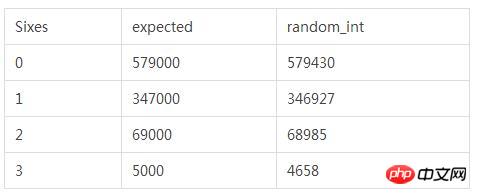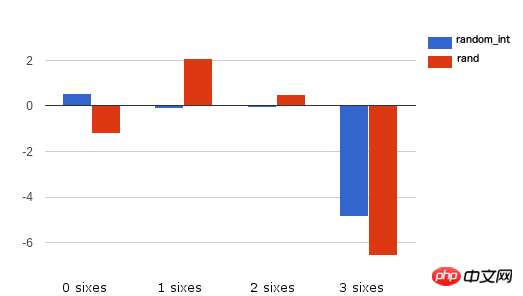CSPRNG function in PHP
This article mainly introduces the CSPRNG function in PHP. Interested friends can refer to it. I hope it will be helpful to everyone.
1. What is CSPRNG
Quoting Wikipedia, a cryptographically secure pseudo-random number generator (Cryptographically Secure Pseudorandom Number Generator, abbreviated CSPRNG) is a pseudo-random number generator. Random number generator (PRNG), which generates pseudo-random numbers suitable for cryptographic algorithms.
CSPRNG may be mainly used for:
Key generation (for example, generating complex keys)
Generate random passwords for new users
Encryption system
Get A key aspect of high-level security is high-quality randomness
2. CSPRNG in PHP7
PHP 7 introduces two new functions that can be used to implement CSPRNG: random_bytes and random_int.
random_bytes function returns a string and accepts an int input parameter representing the number of bytes of the returned result.
Example:
$bytes = random_bytes('10'); var_dump(bin2hex($bytes)); //possible ouput: string(20) "7dfab0af960d359388e6"
random_int function returns an int number within the specified range.
Example:
var_dump(random_int(1, 100)); //possible output: 27
##3. Background running environment
The randomness of the above functions varies depending on the environment:On windows, CryptGenRandom() is always used.
On other platforms, arc4random_buf() will be used if available (established on BSD series or systems with libbsd)
If none of the above is true, a Linux system call getrandom(2) will be used.
If not, /dev/urandom will be used as the last available tool
If none of the above works, the system will throw an error
A good random number generation system ensures appropriate generation "quality". To check this quality, a series of statistical tests are usually performed. Without delving into complex statistics topics, comparing a known behavior to the results of a number generator can help with quality assessment.
A simple test is the dice game. Assume that the probability of rolling a dice once to get a result of 6 is 1/6, then if I roll 3 dice at the same time 100 times, the result will be roughly as follows:
0 6 = 57.9 times
1 6 = 34.7 times 2 6s = 6.9 times
3 6s = 0.5 times
The following is the code to implement rolling dice 1,000,000 times:
$times = 1000000;
$result = [];
for ($i=0; $i<$times; $i++){
$dieRoll = array(6 => 0); //initializes just the six counting to zero
$dieRoll[roll()] += 1; //first die
$dieRoll[roll()] += 1; //second die
$dieRoll[roll()] += 1; //third die
$result[$dieRoll[6]] += 1; //counts the sixes
}
function roll(){
return random_int(1,6);
}
var_dump($result);
Using PHP7's random_int and simple rand function may get the following results
 If you see rand and random_int first, more For a good comparison we can apply a formula and plot the results on a graph. The formula is: (php result-expected result)/expected result raised to the 0.5 power.
If you see rand and random_int first, more For a good comparison we can apply a formula and plot the results on a graph. The formula is: (php result-expected result)/expected result raised to the 0.5 power.
The result graph is as follows:
 (values close to 0 are better)
(values close to 0 are better)
Although the results of 3 6's do not perform well, and This test is too simple for practical applications. We can still see that random_int performs better than rand.
Furthermore, the security level of our application is due to the unpredictability and repeatable behavior of the random number generator. promote.
Summary: The above is the entire content of this article, I hope it will be helpful to everyone's study.
Related recommendations:
Execution Cycle Example Analysis of PHP Principles
##Detailed explanation of PHP source code directory structure and function description
##
The above is the detailed content of CSPRNG function in PHP. For more information, please follow other related articles on the PHP Chinese website!

Hot AI Tools

Undresser.AI Undress
AI-powered app for creating realistic nude photos

AI Clothes Remover
Online AI tool for removing clothes from photos.

Undress AI Tool
Undress images for free

Clothoff.io
AI clothes remover

Video Face Swap
Swap faces in any video effortlessly with our completely free AI face swap tool!

Hot Article

Hot Tools

Notepad++7.3.1
Easy-to-use and free code editor

SublimeText3 Chinese version
Chinese version, very easy to use

Zend Studio 13.0.1
Powerful PHP integrated development environment

Dreamweaver CS6
Visual web development tools

SublimeText3 Mac version
God-level code editing software (SublimeText3)

Hot Topics
 1386
1386
 52
52
 PHP 8.4 Installation and Upgrade guide for Ubuntu and Debian
Dec 24, 2024 pm 04:42 PM
PHP 8.4 Installation and Upgrade guide for Ubuntu and Debian
Dec 24, 2024 pm 04:42 PM
PHP 8.4 brings several new features, security improvements, and performance improvements with healthy amounts of feature deprecations and removals. This guide explains how to install PHP 8.4 or upgrade to PHP 8.4 on Ubuntu, Debian, or their derivati
 How To Set Up Visual Studio Code (VS Code) for PHP Development
Dec 20, 2024 am 11:31 AM
How To Set Up Visual Studio Code (VS Code) for PHP Development
Dec 20, 2024 am 11:31 AM
Visual Studio Code, also known as VS Code, is a free source code editor — or integrated development environment (IDE) — available for all major operating systems. With a large collection of extensions for many programming languages, VS Code can be c
 7 PHP Functions I Regret I Didn't Know Before
Nov 13, 2024 am 09:42 AM
7 PHP Functions I Regret I Didn't Know Before
Nov 13, 2024 am 09:42 AM
If you are an experienced PHP developer, you might have the feeling that you’ve been there and done that already.You have developed a significant number of applications, debugged millions of lines of code, and tweaked a bunch of scripts to achieve op
 How do you parse and process HTML/XML in PHP?
Feb 07, 2025 am 11:57 AM
How do you parse and process HTML/XML in PHP?
Feb 07, 2025 am 11:57 AM
This tutorial demonstrates how to efficiently process XML documents using PHP. XML (eXtensible Markup Language) is a versatile text-based markup language designed for both human readability and machine parsing. It's commonly used for data storage an
 Explain JSON Web Tokens (JWT) and their use case in PHP APIs.
Apr 05, 2025 am 12:04 AM
Explain JSON Web Tokens (JWT) and their use case in PHP APIs.
Apr 05, 2025 am 12:04 AM
JWT is an open standard based on JSON, used to securely transmit information between parties, mainly for identity authentication and information exchange. 1. JWT consists of three parts: Header, Payload and Signature. 2. The working principle of JWT includes three steps: generating JWT, verifying JWT and parsing Payload. 3. When using JWT for authentication in PHP, JWT can be generated and verified, and user role and permission information can be included in advanced usage. 4. Common errors include signature verification failure, token expiration, and payload oversized. Debugging skills include using debugging tools and logging. 5. Performance optimization and best practices include using appropriate signature algorithms, setting validity periods reasonably,
 PHP Program to Count Vowels in a String
Feb 07, 2025 pm 12:12 PM
PHP Program to Count Vowels in a String
Feb 07, 2025 pm 12:12 PM
A string is a sequence of characters, including letters, numbers, and symbols. This tutorial will learn how to calculate the number of vowels in a given string in PHP using different methods. The vowels in English are a, e, i, o, u, and they can be uppercase or lowercase. What is a vowel? Vowels are alphabetic characters that represent a specific pronunciation. There are five vowels in English, including uppercase and lowercase: a, e, i, o, u Example 1 Input: String = "Tutorialspoint" Output: 6 explain The vowels in the string "Tutorialspoint" are u, o, i, a, o, i. There are 6 yuan in total
 Explain late static binding in PHP (static::).
Apr 03, 2025 am 12:04 AM
Explain late static binding in PHP (static::).
Apr 03, 2025 am 12:04 AM
Static binding (static::) implements late static binding (LSB) in PHP, allowing calling classes to be referenced in static contexts rather than defining classes. 1) The parsing process is performed at runtime, 2) Look up the call class in the inheritance relationship, 3) It may bring performance overhead.
 What are PHP magic methods (__construct, __destruct, __call, __get, __set, etc.) and provide use cases?
Apr 03, 2025 am 12:03 AM
What are PHP magic methods (__construct, __destruct, __call, __get, __set, etc.) and provide use cases?
Apr 03, 2025 am 12:03 AM
What are the magic methods of PHP? PHP's magic methods include: 1.\_\_construct, used to initialize objects; 2.\_\_destruct, used to clean up resources; 3.\_\_call, handle non-existent method calls; 4.\_\_get, implement dynamic attribute access; 5.\_\_set, implement dynamic attribute settings. These methods are automatically called in certain situations, improving code flexibility and efficiency.




